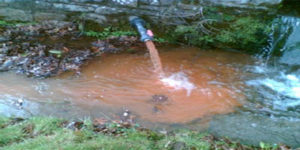Iron and Manganese Removal
The presence of iron is probably the most common water problem faced by consumers and water treatment professionals. The maximum contaminant levels for iron and manganese in potable water are 0.3 milligrams per litre (mg/l) and 0.05 mg/l, respectively. Iron and manganese in excess of the suggested maximum contaminant levels usually results in discoloured water and staining of sanitary ware and clothing. Iron stains a browny, orange colour; Manganese leaves black particles on fixtures and pipe work.
Removing iron and manganese from a water supply is not as straight forward as other treatment methods; treatment is dependent on some or all of the following things:
- Amount and type of iron: There are three main types of iron in water, Ferrous Iron, Ferric Iron and bacterial iron all of which require differing treatment methods to remove them.
- Other chemical and mineral parameters in the water: Sometimes the chemical or mineral composition of the water won’t allow the iron removal system to work effectively so one or more treatment methods may be required in addition to the iron removal unit.
Iron
Iron, which is found in both the ferrous (Fe2+) and ferric (Fe3+) state, is the fourth most abundant element in the earth’s crust. Under reducing conditions in water, the mobile ferrous ion is present but upon exposure to air, it is oxidized to the less mobile form and precipitated as the ferric ion.
Concentrations of iron in aerated surface waters are usually less than 0.5 mg/L but can be substantially greater in groundwater. Few adverse effects are attributable to the presence of iron. In water, iron can discolor cloths, plumbing fixtures, and cause scaling which encrusts pipes. Excessive concentrations may also promote bacterial activity in pipes. Iron is however highly objectionable for drinking water because of its bittersweet astringent taste.
Manganese
Manganese is similar to iron in its chemical behavior and is frequently found in association with iron. Manganese is not usually present in appreciable concentrations in surface water. It seldom reaches concentrations of 1.0 mg/L in natural surface waters and is usually present in quantities of 0.2 mg/L or less. Higher levels may be found in ground waters, deep lakes, and reservoirs. Problems attributed by manganese are not considered to be health related, but rather aesthetic and economic in nature.Concentrations in excess of 0.2 mg/L may make water distasteful to drink.An objective of less than 0.01 mg/L has been recommended to minimize dark brown or black stains on fabrics and porcelain.
Iron & Manganese Oxidation
Iron is oxidized from water extremely fast, however, little manganese oxidation occurs at low ozone dosages. Manganese oxidation (Mn2+ MnO2) requires more oxidation power than the conversion of Fe2+ Fe (OH)3, therefore, only after the reduced iron is oxidized does the oxidation of Manganese begin. One can readily oxidize iron in groundwater and water of low organic content. Ozone has extremely fast kinetics when it comes in contact with Fe. Basically 0.43O3/mg Fe and 0.88O3/mg Fe is needed. The presence of organic material inhibits removal of iron and manganese. So you have to get rid of the organics before you start oxidizing the manganese. This can be accomplished by using an acid pH of 5. Ozone oxidizes most of the iron and turns it into vary stable iron complexes. Manganese oxidation is most effective around a pH level of 8 Oxidation of metals such as iron and manganese is quick and efficient over a wide pH range. Iron in the ferrous state will be rapidly oxidized by ozone to the ferric state whereby gelatinous ferric hydroxide will precipitate. Soluble manganate occurs in the divalent form and will be oxidized by ozone to the tetravalent form also very rapidly. Tetravalent manganese hydrolyzes, and it will produce insoluble manganese oxydehydroxide which can be precipitated over a filter bed.


